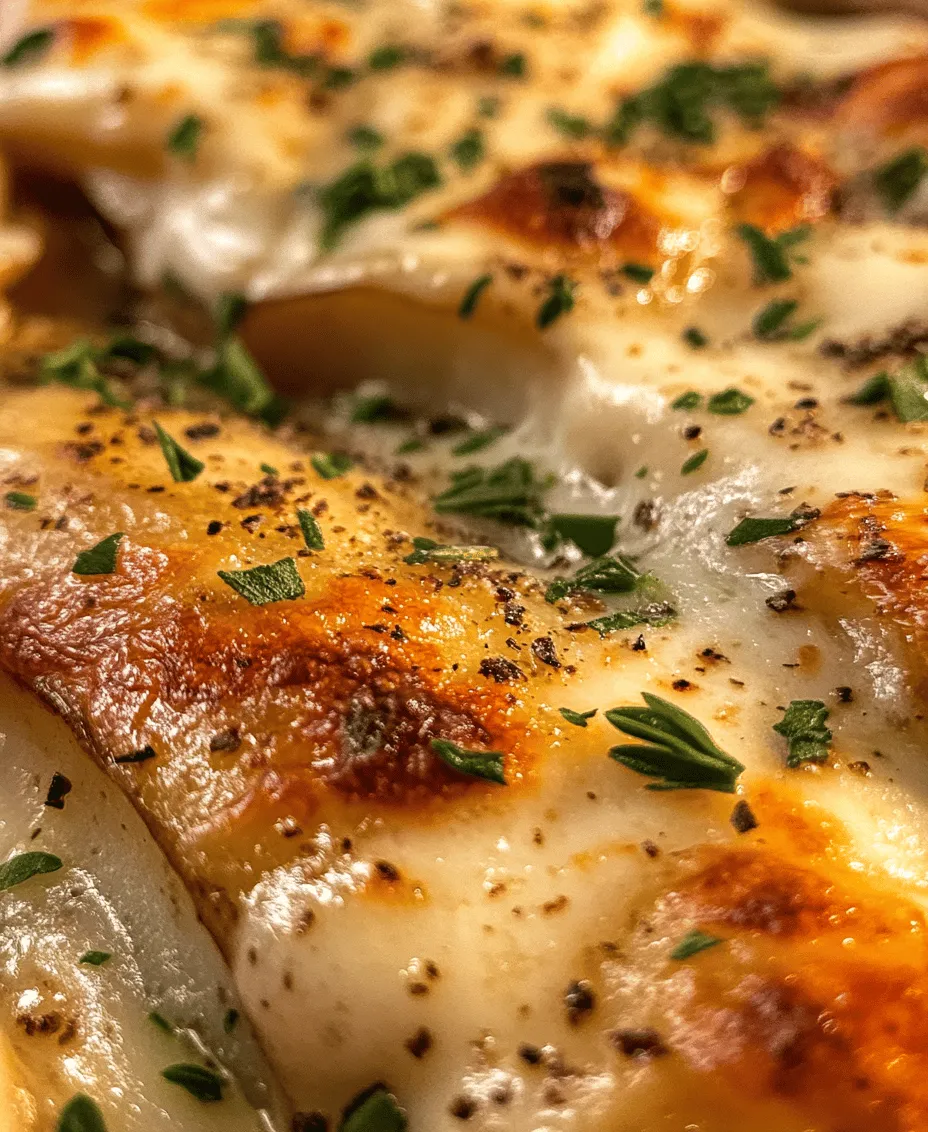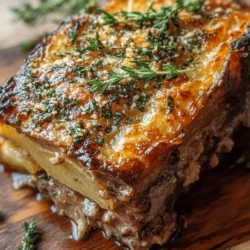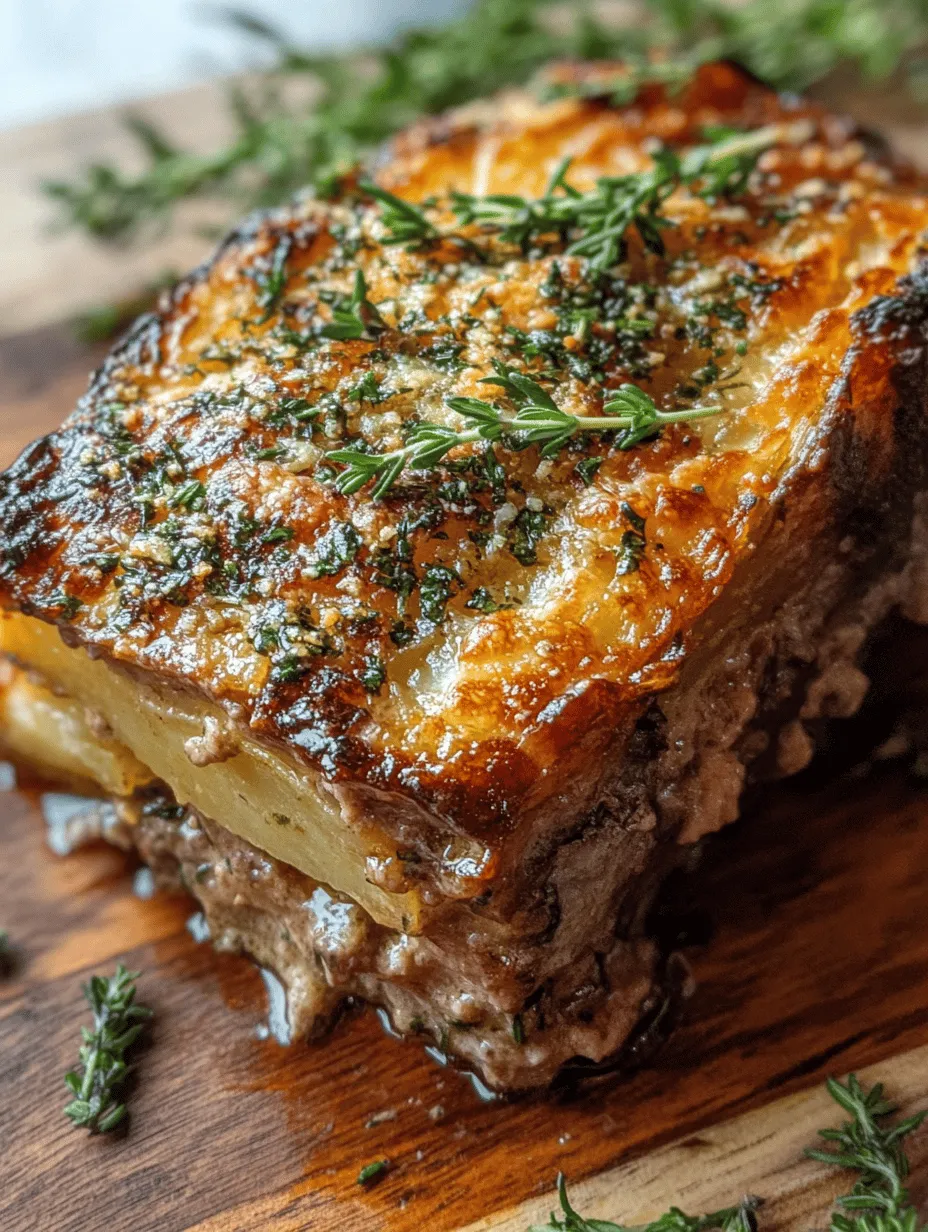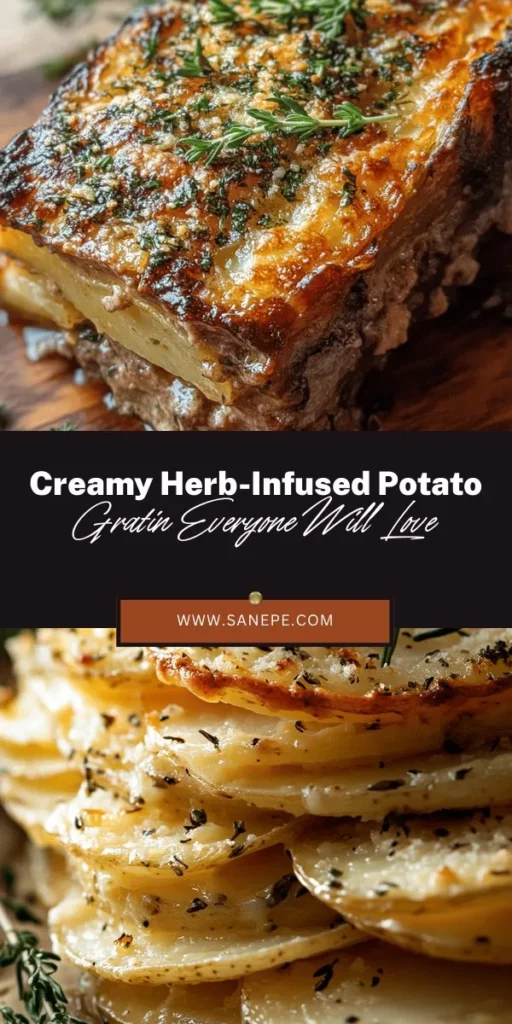Introduction
Potato gratin is one of those dishes that evokes warmth and comfort, a classic staple that has graced dinner tables for generations. This creamy, decadent dish, often layered with thinly sliced potatoes and baked until golden brown, boasts a rich flavor and velvety texture that makes it an irresistible side or even a main course. When prepared correctly, a potato gratin should strike the perfect balance between creamy and crispy, with each bite delivering a satisfying contrast that keeps you coming back for more.
In the realm of gratins, the creamy herb-infused potato gratin stands out as a delightful variation, elevating the traditional recipe with aromatic herbs and a luscious sauce. This dish not only enhances the flavor profile but also adds a touch of elegance to any meal, making it a perfect accompaniment to roasted meats, grilled vegetables, or simply on its own as a vegetarian delight.
Understanding Potato Gratin
Definition and History of Gratin Dishes
The term “gratin” originates from the French word “gratter,” which means “to scrape.” It refers to a cooking technique where ingredients are baked with a crispy top, typically achieved through the use of cheese, breadcrumbs, or a combination of both. Gratin dishes can be made with a variety of ingredients, including vegetables, pasta, and, of course, potatoes.
Historically, gratins can be traced back to the early 18th century in France, where they became a popular way to showcase seasonal produce. The layering of ingredients combined with a creamy sauce is not only a way to enhance flavor but also an ingenious method of utilizing leftovers. As gratin recipes evolved, they adapted to include regional ingredients and preferences, leading to the diverse array of gratins we enjoy today.
Common Ingredients and Variations Found in Gratin Recipes
At the heart of any gratin is the combination of ingredients that contribute to its flavor and texture. While potato gratin is perhaps the most beloved form, variations abound, showcasing seasonal vegetables like zucchini, cauliflower, or root vegetables. The common components in a gratin include:
– Potatoes: The star of the dish, providing a hearty base.
– Cream: The element that imparts richness and depth.
– Cheese: Often layered or sprinkled on top for a golden, crispy finish.
– Herbs and Spices: For added flavor, freshness, and complexity.
Gratin recipes can vary significantly in flavor depending on the choice of cheese, herbs, and seasonings. Some may opt for the inclusion of bacon or ham for a savory twist, while others keep it vegetarian to highlight the earthiness of the vegetables.
The Role of Potatoes in Gratin and Why Russet Potatoes are Ideal
When it comes to choosing the perfect potatoes for a gratin, russet potatoes reign supreme. Their high starch content allows them to absorb the creamy sauce beautifully while maintaining their shape during baking. Russets also provide a fluffy interior when cooked, creating a delightful contrast to the rich, creamy sauce enveloping them.
Other potato varieties, such as Yukon golds or red potatoes, may also be used, but they tend to have a waxier texture that can lead to a denser gratin. If you desire a creamy and smooth texture that melts in your mouth, russet potatoes are the clear choice for this dish.
Ingredients Breakdown
To create the ultimate creamy herb-infused potato gratin, each ingredient plays a pivotal role in the overall flavor and texture. Here’s a closer look at what you will need:
– Russet Potatoes: As previously mentioned, russets are the ideal choice for their starchy, fluffy texture. They absorb flavors well and contribute to the creamy consistency of the gratin. Aim for medium-sized potatoes, which will yield enough slices for even layering in your dish.
– Heavy Cream and Whole Milk: The combination of heavy cream and whole milk is essential for achieving the desired creaminess in your gratin. While heavy cream adds richness, whole milk lightens the mixture slightly, preventing the dish from becoming overly heavy. This balance creates a velvety sauce that clings perfectly to the potatoes.
– Garlic: Fresh garlic is a must for enhancing the flavor profile of your gratin. Its aromatic qualities infuse the cream with a subtle yet distinct flavor that complements the earthiness of the potatoes. Minced or thinly sliced, garlic will caramelize as it bakes, adding depth and warmth to each bite.
– Gruyère and Parmesan Cheese: The cheese factor in a gratin cannot be overstated. Gruyère cheese is known for its nutty, slightly sweet flavor and excellent melting properties, making it a top choice for gratin recipes. Combining it with freshly grated Parmesan cheese adds a salty, umami kick that elevates the overall taste. Together, they create a beautifully golden, crispy crust that contrasts the creamy filling.
– Fresh Herbs: Fresh rosemary and thyme are the stars in this creamy herb-infused variation. Their aromatic qualities lend an earthy, fragrant note that brightens the dish and complements the richness of the cream and cheese. Using fresh herbs is crucial, as they provide a vibrant flavor that dried herbs simply cannot replicate.
– Optional Nutmeg: A pinch of freshly grated nutmeg can enhance the flavors in your gratin, adding a warm, nutty undertone that harmonizes beautifully with the cream and cheese. While it’s optional, nutmeg can elevate your dish to new heights, so consider adding it for a unique twist.
– Fresh vs. Dried Ingredients: When it comes to herbs, always opt for fresh over dried. Fresh herbs not only have a more vibrant flavor but also add a visual appeal to the dish. Dried herbs can be used in a pinch, but they often lack the complexity and brightness that fresh herbs bring to the table.
Preparation Steps for Creamy Herb-Infused Potato Gratin
Now that we’ve covered the ingredients, it’s time to dive into the preparation of this delicious creamy herb-infused potato gratin. Proper preparation is key to achieving the perfect texture and flavor. Here are the essential initial steps:
Preheating the Oven: Why Temperature Matters
Before you begin assembling your gratin, make sure to preheat your oven to 375°F (190°C). Preheating is crucial because it ensures that the gratin cooks evenly from the start, allowing the layers of potatoes to become tender while the top develops a crispy, golden crust. An adequately heated oven will also help to prevent the dish from becoming soggy, ensuring that each layer remains distinct and perfectly cooked.
Greasing the Baking Dish: Ensuring Easy Serving
To ensure that your creamy herb-infused potato gratin comes out of the baking dish cleanly and easily, generously grease your chosen baking dish with butter or cooking spray. This step is essential for preventing sticking and allows for easy serving without leaving precious bits of the gratin behind. Using a 2-quart baking dish or a similar-sized casserole dish is ideal for this recipe, providing enough space for layering the potatoes and sauce without overcrowding.
Once you’ve prepped your dishes and gathered all your ingredients, you’re well on your way to creating a comforting and flavorful creamy herb-infused potato gratin. The next steps will guide you through slicing the potatoes, preparing the creamy herb sauce, and assembling the gratin for baking. Stay tuned for the continuation of this delicious recipe, where you’ll learn how to bring all these elements together for a truly delightful dish.

Making the Cream Mixture: Techniques for Blending Flavors
To create the perfect creamy herb-infused potato gratin, starting with an expertly crafted cream mixture is essential. The base of this dish is a blend of heavy cream and milk, which will provide the rich, velvety texture that distinguishes a stellar gratin from an average one. Begin by combining equal parts of heavy cream and whole milk in a mixing bowl. This combination not only enhances the creaminess but also helps to balance the richness.
Next, add minced garlic and finely chopped fresh herbs—such as thyme, rosemary, and parsley. These herbs impart a fragrant aroma and bright flavor that will infuse every layer of the gratin. Use a whisk to blend the ingredients thoroughly; this technique helps to release the essential oils from the herbs, ensuring that their flavors are evenly distributed. Don’t forget to season the mixture with salt and freshly ground black pepper. A pinch of nutmeg can also elevate the dish, adding warmth and depth to the creamy base.
Layering Potatoes: Tips for Even Cooking and Flavor Distribution
Once your cream mixture is prepared, it’s time to focus on the potatoes. For this recipe, Yukon Gold or Russet potatoes are ideal due to their starch content, which contributes to a creamy texture when cooked. Begin by peeling the potatoes and slicing them thinly, ideally around 1/8 inch thick. A mandoline slicer can help achieve uniform slices, promoting even cooking.
When layering the potatoes in a greased baking dish, start with a thin layer of the cream mixture at the bottom. This prevents sticking and allows for easy serving later. Follow this with a layer of potato slices, overlapping them slightly to create a visually appealing presentation. Pour a portion of the cream mixture over the potatoes and sprinkle some shredded cheese for added flavor. Repeat this process until you reach the top of the dish, finishing with a generous layer of cream and cheese to create a golden crust as it bakes.
Baking Process: Timing and Temperature Considerations
The baking process is crucial in transforming your ingredients into a cohesive, delicious dish. Preheat your oven to 375°F (190°C). This moderate temperature allows the potatoes to cook through while ensuring that the top becomes beautifully golden and crispy. Cover the baking dish with aluminum foil for the first 45 minutes of baking; this traps steam and helps the potatoes to soften.
After 45 minutes, remove the foil to let the top crisp up. Continue to bake for an additional 30-40 minutes, or until the potatoes are tender when pierced with a fork, and the top is golden brown. The total baking time can range from 1 hour 15 minutes to 1 hour 30 minutes. Keep a close eye on the gratin during the final stages of baking, as ovens can vary in heat distribution.
Resting Period: Understanding the Science Behind Setting
Once you remove the potato gratin from the oven, patience is key. Allow it to rest for at least 15-20 minutes before serving. This resting period is essential as it allows the starches to set and the flavors to meld together. The cream will thicken slightly as it cools, making it easier to cut and serve without falling apart. This setting time is similar to letting a cake cool; it ensures that every slice holds its shape beautifully.
Flavor Profiles of the Dish
The Balance of Creaminess and Cheesiness
The creamy herb-infused potato gratin achieves a delightful balance between its rich, creamy base and the sharpness of the cheese. The combination of Gruyère and Parmesan cheese not only enhances the flavor but also contributes to a wonderfully gooey texture. As the gratin bakes, the cheese melts and forms a crust that adds a satisfying contrast to the tender potatoes beneath.
The Aromatic Contribution of Fresh Herbs
Fresh herbs elevate the dish’s flavor profile, providing layers of aroma and taste. Thyme brings a subtle earthiness, while rosemary offers a slightly pine-like flavor. Parsley adds freshness that brightens the overall dish. This aromatic blend is what makes each bite of the gratin more complex and inviting.
How the Baking Process Enhances the Overall Flavor and Texture
The baking process caramelizes the natural sugars in the potatoes while allowing the cream to reduce and thicken. This Maillard reaction not only creates a golden crust but also enhances the flavor, resulting in a gratin that has a rich, savory depth. The combination of creamy, cheesy layers with crispy tops creates a delightful textural contrast that is sure to impress.
Pairing Suggestions for Enhancing the Dining Experience
Creamy herb-infused potato gratin pairs beautifully with a variety of proteins and side dishes. For the perfect main course, consider pairing it with roast chicken or grilled meats like steak or pork chops. The richness of the gratin complements the savory flavors of these dishes. For lighter options, a simple mixed green salad dressed with a tangy vinaigrette can provide a refreshing contrast to the creaminess of the gratin.
Nutritional Aspects of Potato Gratin
Overview of the Nutritional Content of the Key Ingredients
Potato gratin, while indulgent, can offer nutritional benefits depending on the ingredients used. Potatoes are a good source of carbohydrates, providing energy and dietary fiber. The addition of milk and cheese contributes calcium and protein, essential for bone health and muscle maintenance. However, it’s essential to be mindful of portion sizes due to the dish’s richness.
Discussion on Portion Control and Serving Size
When it comes to serving creamy herb-infused potato gratin, moderation is key. A standard serving size is typically around 1 cup, which provides a satisfying amount while allowing you to enjoy the flavors without overindulging. Pairing it with lean proteins and vegetables can help create a balanced meal.
Potential Substitutions for Dietary Restrictions
For those with dietary restrictions, several substitutions can make this dish more accessible. To create a lactose-free version, consider using lactose-free milk and cheese alternatives made from nuts or soy. For a lighter option, you can replace part of the heavy cream with a lower-fat milk or even vegetable broth, though this will alter the creamy texture slightly. Additionally, for a vegan version, try substituting the dairy products with plant-based alternatives and using nutritional yeast for a cheesy flavor.
Serving Suggestions
Ideal Occasions for Serving Creamy Herb-Infused Potato Gratin
This creamy herb-infused potato gratin is a versatile dish that can elevate any occasion. It’s an excellent choice for holiday gatherings, family dinners, or potluck events. Its comforting nature makes it a favorite during chilly months, bringing warmth and satisfaction to any table.
Pairing with Proteins
As mentioned earlier, the gratin pairs wonderfully with proteins. Roast chicken is a classic option, offering a savory contrast to the creamy potatoes. Grilled meats, such as steak or lamb, also complement the dish nicely. For a vegetarian option, consider serving it alongside stuffed bell peppers or a hearty vegetable dish.
Complementary Side Dishes to Enhance the Meal
To round out your meal, consider serving the gratin with complementary side dishes. A crisp green salad with vinaigrette adds freshness to balance the richness of the gratin. Roasted vegetables, such as Brussels sprouts or carrots, provide additional nutrients and color to the plate. For a more indulgent experience, garlic bread or a warm baguette can be a delightful addition.
Conclusion
In summary, creamy herb-infused potato gratin is a versatile and comforting dish that can be enjoyed on various occasions. Its rich flavors and creamy texture make it a favorite among comfort food lovers. The beauty of this gratin lies in its adaptability; feel free to experiment with different cheeses, herbs, and seasonings to make it your own.
Embrace the opportunity to add personal touches, whether it’s incorporating seasonal vegetables or trying out different flavor profiles. Comfort food has a special place in culinary traditions, offering not only nourishment but also a sense of warmth and community. So gather your loved ones, serve this delicious gratin, and create lasting memories around the dinner table.


